Neil Koenig, former BBC Producer/Director and now ideaXme board advisor interviews artist Shahzia Sikander.
Neil Koenig comments:
One aim of the ideaXme platform is to Move the human story forward™. Is that something that art can help with? The artist Shahzia Sikander believes it can: “art is something that we learn to tell stories with. It’s a means, a catalyst, but it also is how you are in pursuit of your own truth or a broader truth” she explains, “but then in that journey, what happens is how you negotiate a place in the world for future generations”. Shahzia Sikander was born in Pakistan and has lived and worked in New York since the 1990s. She has created works in many different forms, from miniatures to animation, sculpture and more. Her first major public art commission, “Havah..to breathe, air, life”, is currently on display in Madison Square Park in the heart of New York City. It includes some dramatic pieces, such as an 18 foot tall sculpture in the centre of the park, and another 8 foot high figure on the roof of a nearby courthouse, where it joins some existing works The show is on view until June 2023, after which it will move on to Houston. In this interview with ideaXme board advisor Neil Koenig, Shahzia Sikander talks about growing up and studying art in Pakistan, her interests in exploring notions of authenticity, assimilation, and “interstitial spaces that are harder to define”, and the role that technology might play in the future development of art.
Shahzia Sikander interview with Neil Koenig
Neil Koenig: [00:00:00] Welcome to ideaXme. Madison Square Park is a green haven in the heart of New York City. And since January 2023, the park and a nearby courthouse have seen the installation of some dramatic public artworks. The show is called Havah …to Breathe, Air, Life, and it is on view in New York until early June 2023. It will then travel to Houston. The pieces on display are the work of the artist Shahzia Sikander.
Shahzia Sikander, Artist
Neil Koenig: [00:00:38] Shahzia, it’s very nice to have you with us. Perhaps we can start by asking you to tell us a little bit about yourself and your background.
Shahzia Sikander: [00:00:46] Very nice to be here. Thank you for inviting me. I am currently here in New York. I am a visual artist. I have lived in New York since 1997, so I guess I can call myself a New Yorker. I also have family in Pakistan. I grew up in Lahore. I lived there and worked there as a young artist and then came to the US as a young adult. And the work that you were mentioning just now, that’s actually my first major public art project and it’s very exciting for me to have the work in New York City and to be able to create and respond to the city and to participate, especially post-Covid. It is quite an exciting moment.
Neil Koenig: [00:01:59] Just describe the two pieces. There’s one in the actual park and then there’s one on top of the courthouse nearby, isn’t there?
Witness and NOW By Shahzia Sikander
Shahzia Sikander: [00:02:08] There are there are two works and actually there are there more than two works. The piece on the inside the park is an 18-foot sculpture and the one on the roof of the courthouse is responding to the existing sculptures there, which is about eight feet.
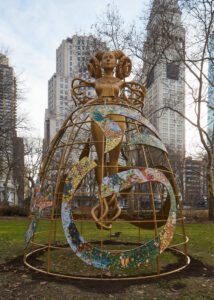
Shahzia Sikander: [00:02:39] The project is part of Madison Square Park’s commission. They do two projects a year. In my conversations with them, which started about two years ago, I was keen to see if there could be a work that could involve the courthouse. So, it was a series of conversations that got started. And thus, the proximity of the courthouse is an exciting idea that’s been activated through these works as well as through an AR (augmented reality) lens that allows the piece, which is on the roof, to be experienced on the ground by park-goers.
Neil Koenig: [00:03:29] Now AR, augmented reality. How does the audience use that to experience extra dimensions of these works?
Shahzia Sikander: [00:03:39] It’s very simple. It’s all through Snapchat. So, it was a lens that was created which exists in Snapchat now. It gets activated by a code which is available or just or just going into Snapchat and then, a sort of a ghost like form called the Apparition of the piece on the roof comes about and you can walk towards the form, you can walk around it, you can interact with it, you can look at it from all different angles. And then, it’ll appear in a kind of a random combination. So, you don’t know where to expect it. But when you see it, it allows you to walk towards it and come really close. You really get to see it in a manner that you can’t from the street level when you’re looking up.
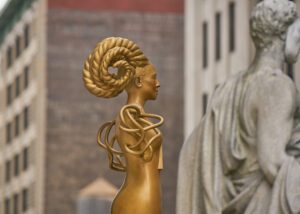
Neil Koenig: [00:04:49] And what themes are you exploring with these works?
Shahzia Sikander: [00:04:53] Both these works have a very strong presence of the feminine, and I think for me that’s really a theme that’s just prevalent in my work. Using the idea of centering the idea of the feminine as something which is very fluid and also non fixed. So, it’s not just the body itself, but how the body can loop in and out of itself and how I can think of it as something more amorphous like the self.
Resilience of Women
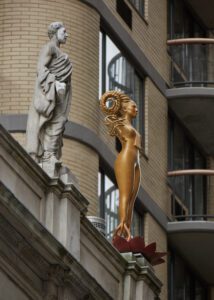
Shahzia Sikander: [00:05:33] It’s also about the body as a site perhaps of resilience for women and many elements in the form in the sculpture have this sort of self-rootedness that happens. The legs are self-rooted into back into the body in a similar manner, the arms. So, there’s this play with the idea of the feminine carrying its roots wherever it goes or the resilience or also suggesting the paradox of rootedness.
Shahzia Sikander: [00:06:11] For me that’s something that often comes up where you question what’s authentic or what’s assimilation, what’s a foreign, what’s the idea of the foreigner versus the local. So, so these sort of the interstitial spaces that get activated, there’s a lot of that happening in these particular works. I think in that sense the AR also allows just an added dimension to that, by offering this form of the feminine that you can’t fully capture because it’s fleeting. It’s something that is so swift or hard to pin down or hard to define or hard to contain in a box.
Shahzia Sikander: [00:07:06] I think it’s all of these tensions that I find are usually like fodder for my work where how to create forms that kind of oppose a binary read, that are full of multiple associations or the multivalence of something. So, you’re not stuck in just a binary read of some something or someone.
Neil Koenig: [00:07:33] Now you’re talking about things that are hard to pin down. And yet in a courtroom, that’s what ultimately happens, isn’t it? Things are pinned down.
Madison Square Courthouse Sculpture
Shahzia Sikander: [00:07:43] But at the same time, what I find is the juridicial norms are often they get revaluated, they get interpreted in and there’s a kind of a change or movement in a similar manner. So, they both art. Art also, they both embody a dynamic which may be, connected to its present moment but over time, it’s not just a non-evolving idea. It has to change and shift in conversation with its present time as well.
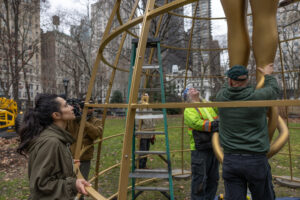
Shahzia Sikander: [00:08:32] I think of it that way, it gives me more freedom to kind of draw links between the context of art within the courthouse. We were talking about, you know, a kind of an allegorical representation of the female. But the sculpture itself is in bronze. It’s pretty precise. It’s it may have an open-ended intent in terms of what how it can be read, but its precision is very active in its in the choice of material in in the drawings. In its shape and form and also kind of a push back. It need not just be, you know, the feminine cannot just simply be the female with her scales. But how can the female be represented as something more of an active agency where she is a thinker, but she’s also a participant and kind of a witness, to the patriarchal histories of art and law. So, then the female is a wider representation because we are talking about traditionally patriarchal spaces, both law and the court, as well as art and the art world.
Neil Koenig: [00:10:07] So, it sounds like this is a way of moving this debate forward. The aim of this series is to talk to people who are keen to Move this human story forward™. Is this something that Art can help with?
Shahzia Sikander: [00:10:24] Absolutely. Like as an artist, I have I believe that. I have to believe it. Art is also something that we learn to tell stories with. It’s a means, a catalyst, but it also is how you are maybe in pursuit of your own truth or a broader truth. But then in that journey, what happens is how you negotiate a place in the world for future generations. So, there is that premise within the space of art. But also, when you think like how you centre your creativity or how you do your research or how it overlaps with the agency of community, then you are you have to cultivate a strong belief in humanity. Also, in the knowledge that, you know, whatever you’re producing, whatever you’re creating or whatever you make, and you consume, but you give back. All of this, it’s not just happening in absence of its time or absence of others or community. So, it has resonance, right? It has consequences which are beyond your immediate life. So, if you if I think of it in that way, then of course I am I, I believe that art enables you as well as the people around you to take some form of power and that how do you transform that into your reality? So, it’s this negotiation that allows you to move forward, move backward, forward, sideways. The movement is important, right? History is also about storytelling.
Neil Koenig: [00:12:29] Did you always know you wanted to be an artist? What was your earliest memory of art?
Shahzia Sikander: [00:12:38] The very, very earliest memories were, around growing up in a multi-generational household with lots of aunts and uncles and cousins, but it was my grandparents’ home and we used to sleep outdoors often in the summer on jute beds, looking at the sky with our grandmother and lots of cousins. So, I think my earliest memories really are about fascination with nature and senses and light or lying awake observing changes in the sky. Colour, light. I think the earliest memories are really the beauty of and the interface with nature. But other memories are made doing art homework of everybody in the house. So, all older cousins, younger cousins, siblings. I remember I would have a pile of books and I did all the science diagrams, the geography diagrams, biology, happily, I think I was in Grade Two and three and four. So, these are early memories.
Neil Koenig: [00:13:57] And what was the art scene like in Pakistan when you were growing up?
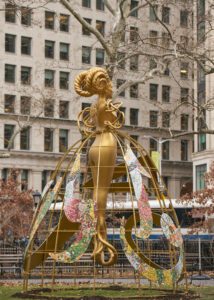
Shahzia Sikander: [00:14:03] I grew up in the 1980’s. So, that was my young time. I have very memories of Zia ul Haq’s military dictatorship. And that’s also a time when cultural shifts are happening far more radically. It was also around the time of the Afghan… war is 1978 to 1992. So, this is that particular era where I do feel the culture was getting more stifled. It was different from my immediate experience of how things were in my household with my grandparents. I think over there, issues regarding belief, spirituality was kind of more of an intrinsic mix, which is spiritual but also secular. And then outside I think the public private spaces were getting more polarized. It was also a time of human rights challenges and issues around women’s rights. All of these things were getting more complex or diminished or there was the emergence of blasphemy laws. So, you did see how somehow it was unfolding in the public space and how it was unfolding, how it was unfolding in the household. For a young adult, there was this tension between these two. So, I experienced that which would be very different from a young person in, you know, post 911 or even in the mid to late 1990s of Pakistan. So, my experience is very clearly of the early 80s. And at that time, I just was gravitating often towards women, mentors were usually women. Maybe because public schooling was often not co-ed. I went to the Kinnaird College for Women. This was before I went to the National College of Art.
Shahzia Sikander: [00:16:35] That was just a place where I think I went to because I was interested in mathematics. So, I was studying math. And then, I don’t know, I wanted to gravitate more towards the humanities because of this kind of climate where you wanted to be able to talk and have debate and, understand what dissent was and what were the kind of intersections of community – poets and writers and thinkers. So that’s how I think I kind of pushed me in that direction. And I ended up, visiting the National College of Art and the school. And I was like, oh, I really like the environment here. And then I decided that I would without my parents’ knowledge at that time, just sat for an exam. Which was a kind of an exam for the entire country, like a federal exam. I did well on it and ended up getting into the art school. And once I had that all sorted out, I think at that time I was like, oh, I really want to study this. And I remember initially in those years, yeah, going to an art school, especially the National College of Art School, was not the way it’s considered now. There was still some reservation. I think I initially got myself from my kind of family commitment that I could go and study architecture. You know, I don’t know why I think it’s because I think my mother was so invested in building like a small home in the backyard of our grandparents’ house. So, this idea of architecture probably spoke to her.
Neil Koenig: [00:18:41] Did you build a house?
Shahzia Sikander: [00:18:43] Yeah, I think they built a house. I was till my early teens sharing a tiny room with my brother in our grandparents’ home. So, with different cousins, aunts, and uncles we were living in very close proximity to each other. So, my father took a job in Mogadishu in those years to save some money. And he moved there. We spent some time in Somalia as well. And at that time, I think they were saving money so they could build a home in my grandparent’s backyard with another uncle. So, the families could have a little bit of separation or independence from the grandparents. And so, it was still living collectively. So then when as I’m talking, I’m thinking my thesis for the manuscript painting department was really focusing on this idea of a home or imagining the space, which is the space where you could move more freely versus the space, the public space where there was a little bit more, restriction, especially movement around female bodies.
Manuscript Painting
Neil Koenig: [00:20:18] And you mentioned manuscript painting. There’s a rich tradition of that, isn’t there, in Asia. And this work that you did as a student, The Scroll was quite an undertaking, wasn’t it?
Shahzia Sikander: [00:20:32] Yeah, it really was. I don’t have the eyesight that I had then. That was a moment in time when before the Internet. It was a sacrifice at that age also because I was making it when I was barely 18. But I would work 14 to 18 hours every day. And it took me definitely more than a year with that level of labour and desire and discipline. I’m glad that whatever that moment was, that I was alive in that moment that I was able to do. I definitely could not do it now.
Neil Koenig: [00:21:21] So tell us about the work. This had a big impact, didn’t it?
Bashir Ahmed Miniature Painter
Shahzia Sikander: [00:21:26] So, we were talking about the 1980s environment. So, when I went to the National College of Art, I became (in your foundation year, you can kind of look around and see what you’re going to major in which department you’re going to go in). So, at that time, it was 1986/87. So, I gravitated towards the miniature painting department. And at that time, it was Bashir Ahmed, the master painter, miniature painter. He was he was in charge. He’d always been in charge of it. But it was a young program because I think he set it up in 1982. So, it was yet very popular. It was still mired in kind of all these problematics of high and low art or something, which is tourist kitsch or something which was more craft oriented versus an intellectually driven space. So that’s, how I encountered it. And it became quite clear to me that this idea of tradition in context to the Indo-Persian manuscript painting craft was a very truncated idea because, it was the residual of colonial histories and education. And there was this paradox of culture and nationalism and manuscript painting kind of embraced all of it, but it was very unresolved at the same time because it could be seen as your national heritage. And at the same time, it was seen as not intellectual.
Shahzia Sikander: [00:23:27] So I became interested in these factors more I have to study it and learn the craft and be, a student of the master painter. I was more interested in these dynamics because, I wanted to understand why we had to study abstract expressionism at that time without much understanding of how it affected our lives versus something that was seen as, not important in terms of learning. So, I was going against the grain in those years, but fast forward to the last ten plus years and it is the most popular Art Department at the National College of Art and almost Pakistan imports this idea of like manuscript, miniature contemporary, miniature, or neo-miniature as a very nationalistic art form. So that’s the role that my work played. It created a major opening up of the potential and also to sort of share that, engaging with tradition. was something that the youth was capable of. And it wasn’t that tradition was bad, or inferior and that the artist did not have to be in service of just Western art history to be avant garde. And so those were things that I was doing very intuitively at that time.
Neil Koenig: [00:25:35] So you were breathing new life into this form.
Opening Up Ideas Around Tradition
Shahzia Sikander: [00:25:41] I think it was more like I was interested in opening up ideas, around tradition. Tradition is not something static or the concept of tradition isn’t sort of stuck in time. It’s who determines what tradition is, is the problematic. Who is saying that this is the only way to understand manuscript histories or pre-modern art form. So, I was intuitively questioning the scholarship around that genre. And most of that scholarship was obviously because of its colonial history, very English, right? So, I was always the outsider. It was a very male white history, and that was intuitively what was not gelling like it seemed like that’s not that’s just one kind of dismissive way of talking about manuscript traditions as very descriptive or unintellectual.
Shahzia Sikander: [00:26:53] I wanted to imagine them in in more kind of open-ended ways where they could be seen as a portal into incredible fantastical worlds as well as their plurality playing kind of an important role in pre-colonial histories as well. So that was all intuitive at that time because there was not much of an art historical armature available to have these critical conversations either around English conquest or its dispersion or the revival of the arts within the academic institution.
Shahzia Sikander: [00:27:38] At that time sort of this identity of what how it could be a Pakistani art form was still very much in in flux. And I think that’s what the timing of my work does, is that it argues that tradition was viable and compatible with the youth and full of possibilities. And I think that’s what happened is I finished my thesis and I was till, you know, 20 or 21. And I was asked to come and teach with Bashir Ahmedright away. And so that gesture itself encouraged other students on the side-lines that may have been wary about prejudice. This is around craft-based work to suddenly engage with the manuscript painting tradition with experimentation. And so that happened in 1991 and 1992. And then as a young artist, I think I became immediately disillusioned with the politics of academia. That’s when I was like, I didn’t want to deal with those tensions of being policed, of where your alliances have to happen. I was still very young and idealistic. I wanted to make my art. So, I think that’s those are my very fond memories of the late 1980s in Pakistan.
Neil Koenig: [00:29:17] And the work itself, The Scroll, just describe that for those who might be listening rather than watching the interview, because it’s rather bigger than the miniature paintings one might have seen in traditional works, which were in parts of books, weren’t they? The pictures were part of manuscripts.
Shahzia Sikander: [00:29:37] It’s about five feet by maybe 14 inches, I created it by painting in very abstract on large scale, canvases and sketches that were far different than The Scroll. So, I created all of these, experimentations before I could finalize a composition for the painting. It had to be done in a certain manner where every tiny square centimetre or millimetre had to be accounted for and filled in with detail and a certain way of applying paint and pigment. So, I started very broad and abstract, and then I kept reducing and adding layers and going deeper and deeper right into the pores of the paper. That’s how I see it. But. It’s a horizontal format and it kind of uses the idea of an interiority, of a space interiority of a home. It’s not literally the home that I grew up in, but it is looking at the interior space. And I was looking also at other at Safavid painting traditions because they also represent a lot of different ways of how the interior and exterior play a role in especially of Sufi philosophy.
Shahzia Sikander: [00:31:35] I was trying to link manuscript painting to a pictorial tradition earlier than the colonial history. So that’s why I was keener to connect it to the Safavid tradition, perhaps to step outside of this very prevalent paradigm of being, the colonizer and the colonized. So, I wanted to step out beyond past that.
Shahzia Sikander: [00:32:00] And then I was also looking at other artists that were engaging with local vernacular, like architecture. So, Nayyar Ali Dada, his work. He’s an eminent Pakistani architect. So how he was engaging with Islamic traditions in terms of architecture and geometry. So, there were other things that I was looking at. I was also looking at film making. I’ve always really liked Kurosawa. So, the depiction of movement and scenes that can play themselves out in contrast so black and white, but playing with colour, but thinking in terms of negative and positive and how that rhythm can move the idea of narrative in a scroll format. So that’s what happens. There is a protagonist in the painting, which is a female, and you never see her face. She’s painted like a ghost. So again, that topic is still prevalent right the AR that I’ve done. But this was how I wanted to append this sort of fetishized, virtuous figure of in the manuscript paintings, the static awaiting woman in the traditional miniatures, by kind of replacing it with something which was more spectral, and she could defy bodily restrictions because she had a very elastic, resilient form.
Shahzia Sikander: [00:33:48] Perhaps that becomes the first attempt at reclaiming the freedom of the female body. So that’s also something that happens in the in the painting.
Neil Koenig: [00:34:01] Wow. So, after you created this work and spent some time in the academic world in Pakistan, you ended up in the US.
Shahzia Sikander: [00:34:15] Oh, my God. That’s so many years. I was teaching and was making my art. And then I was also thinking it would be it would be great to have an opportunity to see things from a different lens. To travel or, moving away from the familiar makes you less complacent. So, I was wanting to do that and so that’s when I kept thinking how could get a scholarship to study. So, it started from reaching out to some artists in India. Gulam Sheikh and Nilima Sheikh in Baroda and I, but I couldn’t get a visa. And you know, and that’s still true. Like even now it’s so hard to get a visa to visit India as a Pakistani national. So that was that was my first desire was, I wanted to go and see some of the syncretic art and histories in India and so couldn’t go there and then think I ended up coming for a show at the Pakistani Embassy in Washington, DC, just on a standby ticket with the art. And then I have this memory of putting some of my work up, just in in the Pakistani embassy for an evening and showed these ex-pats, but nobody bought anything.
Shahzia Sikander: [00:36:04] It was a huge disappointment. But it was such a blessing because then had all this work and they were all small paintings, and I could assemble them in a portfolio. So, I ended up calling up many art schools and taking my work physically to whomever, I was able to get a meeting with.
Shahzia Sikander: [00:36:28] I ended up getting into several art schools and negotiating a financial aid for myself. But the world or the art world, everything was a different moment. We’re talking 1992 and 1993. So, I ended up changing my tourist visa into a student visa and went and spent two years at the Rhode Island School of Design.
Shahzia Sikander: [00:37:02] So that was the beginning of another journey. But over the years, over in the early years, I think a lot of the art that I started to create was also about resisting a sort of straitjacketing that I encountered in the West in terms of, how I was seen and how sometimes there was less understanding or acknowledgement of the art and more a desire to see everything through my biography. So that was really a struggle because that just felt very alien.
Shahzia Sikander: [00:37:48] I thought, why can’t we talk about the art and how what is this process of how you become the other? What is causing this? And those prevalent polarizing situations are still around the East/ West Asian/White, our cultures Islam/West. Some of these things are still deeply rooted. So, I feel like in the early works, it’s a resistance to that type of burden that I felt was getting projected onto me that felt almost alien or unfair. And I didn’t want to be responsible of carrying that burden, of representing a culture or a religion. So, the work that happens is sort of this outburst of fragmented severe bodies. And many of them are kind of genderless or androgynous and, they’re half human, half headless torsos, half animals, sort of kind of a dislocated forms that refuse to be pinned down or they refuse narrow representations.
Neil Koenig: [00:39:20] One of the many remarkable things about your work is the huge range of different forms you’ve explored from miniatures to AR, animation to sculpture. Can you talk a little bit about how you know how that process unfolds?
Shahzia Sikander: [00:39:47] So first of all, it’s 30 years of work. So, it hasn’t been one thing. It’s been a very natural progression of how things have evolved and what led to what, but also feel like sometimes such questions are not asked of other artists. Like would you ask something similar to Kentridge, for example? You know, I’m thinking somebody like Kentridge who also makes animations and films and installations and sculpture and mosaic and practice his drawing. But I don’t think anybody asks him: Why do you work in so many forms?
Neil Koenig: [00:40:32] Perhaps they should!
Shahzia Sikander: [00:40:35] I feel that’s also a symptom of how you create the othering. Oh, you’re a South Asian female artist. So, you are seen as the miniature painter, so maybe you should stick and just keep making the miniatures.
Shahzia Sikander: [00:40:53] I think there’s a little bit of that that I just wanted to put out there for the audience to question that. But how I think of my practice is that I think of it as the foundation or the thing that connects everything is drawing. And for me, drawing is my means of collaborating with all sorts of languages like drawing becomes like a libretto when I’m working with the composer. Drawing is almost like writing when I’m thinking out ideas.
Shahzia Sikander: [00:41:29] And even in terms of my kind of current project, large scale sculpture, what I did was I took a painting, and I was interested in what would happen if I took my painting and made that into a sculpture. Would the stakes be different? Will the audience suddenly shift? Will the conversations shift around that? So, I was basically invested in that. Can I deconstruct my work and see what tends to happen? Will the conversations around the work change? So that’s how I started to think of a space, because in the manuscript painting tradition, how I enjoy looking at the historical works is that it feels like there is so much space that has been condensed and captured. So, they may be small in space, in scale, but they are heroic in their depiction of space. So, it was also what if I took one element out of these perfect paintings? What would happen? Will they unravel? And as I started to think like that, I really wanted to be like, oh, what if I did that? How could I create that type of chaos in my read of a historical painting? So obviously the early experiments were walls, drawings and working with layers and then building that up into digital, in animations, early animations, which kind of I think preserved that performative act of drawing on paper, but also how ink wash paper, they become tools to kind of think in layers.
Shahzia Sikander: [00:43:30] And the same is true if I think of 20 years later, of making very complex films with composers and poets and multi-channel works. But if you think of the idea of the pixel, I can equate it to the notion of the unit of the mosaic. So suddenly the pixel and the mosaic allow the animation to create a dialogue with mosaic. So, there’s a strong link in terms of how I see it. And that type of parallel suddenly allows me to then shift the scale and do public art projects. Drawings don’t have that type of luxury or longevity because many institutions put the works of paper in storage for long periods of time. And I was like, how do I counter that? So then, time-based work evolves into these engagements with glass. Glass allows a sensitivity to light and malleability of material that is very similar to drawing.
Neil Koenig: [00:44:59] The current show in New York does make use of some technological innovations. And some critics have been perhaps a little sceptical about technology and art. And what’s your take on technology? Does it have something to offer the art world?
Shahzia Sikander: [00:45:21] Oh, absolutely. Technology is changing, so what was innovative, when I was experimenting in 2000, there was no high definition. So, it’s constantly keeps you on your toes. So, it may be seen as something very innovative and experimental conceptually and philosophically, but it’s also something that gets dated really fast as well. So, it is something that is constant too. So, it is this dance with technology which I find very exciting and also something – I don’t want my work to be subservient to a software ever. So, I’m aware of how much negotiation I want. And at the same time, I’m very dependent on my skills as a draftsperson or my ability to draw. And so, the control resides in my hand. And then the technology can come in and out. And that’s the space that I have carved for myself. It may be very different for another artist, older or younger, how they’re engaging with technology. But that’s how I’ve always thought – I’ve wanted it. I’m interested in it, but also want to keep the hand very much present in my work.
Neil Koenig: [00:47:10] I also noticed that in your statement accompanying the Madison Square Park show, you mentioned this phrase thinking through your hands. I wonder if you could talk about that a bit.
Shahzia Sikander: [00:47:25] Well, for me, it’s like maybe in another life I would love to be a writer. Manuscript paintings have such this beautiful relationship with text and with image. But sometimes, the text is hidden. Many of these paintings have been dismembered. So, we don’t really fully we see the emphasis often on the painting and not necessarily on the visual aspects of the text, but sometimes the text underpins a story. So, no matter what this relationship with the precision that sometimes words offer and the open ended-ness that maybe the visual interpretation demands, this tension for me has always been something that I dwell on.
Shahzia Sikander: [00:48:29] I appreciate the precision that words offer, but then also love the timelessness that a poet is able to create by use of playful usage of words. But they crystallize a moment in time. And so often I think of myself, okay, the closest that I can draw a parallel to when I’m making a painting is I’m creating a poem. And why do I think like that? Like, what is it? So, it’s often this amazing interest and love and respect for the manipulation that a poet has with words. So that’s probably where that comes from this idea that drawing is an act of a thinker or how, my tool is my hand, but I can draw better than perhaps I can write So that’s where this idea of writing and equating, drawing with thought comes from and thinking through the hand but also even not lack of trust with technology. But yeah, I like the irregularities, the unexpected things that happen with the hand. It can never be the same thing. It’s not going to be the same thing. It’ll always be different. And so, there’s going to be a detour. There’s going to be something. The erasure is part of it. It all the complexity that comes. That the human experience, human mind, human, like you’re tapping into all of it. I trust that. That’s something that I’m carrying is tapping into a collective space. Which would be different from the repetitive nature of a software or a completely fabricated thing that’s going to happen again and again in the same manner. So that’s perhaps why I think of it as something which is very mercurial, right? Part of it is in your hands and part of it is going to change every time. And then that’s very much how art functions. It’s also so much of it is in your control. But once the art exits and it’s in public space, it’s also a others’ perception.
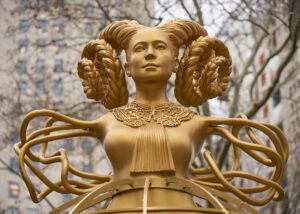
Neil Koenig: [00:51:06] It has a life of its own at that point, perhaps?
Shahzia Sikander: [00:51:09] And that’s how cultures are. That’s how histories are. Nothing is static. It’s all dynamic. And that’s why they cannot just be one way of seeing the other or seeing ourselves. And that’s the tension. How can you create work without tying yourself to just a very heteronormative lineage? There are many, many notions of the diaspora. There are many notions, there are many representations. And then they start overlapping. So, then that’s that becomes the in-between space, the intermediary, the interstices that are harder to define. And that’s the space usually that I tend to gravitate towards.
Neil Koenig: [00:52:09] Fascinating. What would be your advice to younger artists, people just starting out?
Shahzia Sikander: [00:52:18] Earlier we were we were talking about what is the function of art. I think everybody has to experience that for themselves. How can you harness creativity as a catalyst? It has to connect with you first. It also perhaps can be seen as a way of living. And how do you enrich those around you? How do you enrich this idea of community? My advice would be to practice, I guess, introspection, resilience and to remain open, curious. Ask questions, ask new questions. it’s not like how what’s the next project or who’s inviting you or not or how to be part of something. It’s how you respond also. Because all of those things are constantly shifting, and they are not necessarily in your control. What can you do as a young artist, to create as well as liberate, to create more equitable a more equitable and just art world and think that that’s what I meant when I said that the story we learned to tell or the stories we are seeking is how we negotiate a space for ourselves, but also for future generations. So, keeping that dance in mind.
Neil Koenig: [00:54:15] Fantastic. Shahzia Sikander. Thank you very much.
Shahzia Sikander: [00:54:20] Thank you so much for inviting me. Appreciate it.
Follow Shahzia Sikander on Instagram @shahzia.sikander
Interview credits: Text, video and audio by Neil Koenig.
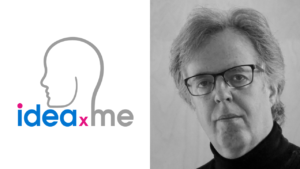
If you liked this interview, be sure to check out our interview with Daniel Birnbaum, Artistic Director, ACUTE Art.
Follow ideaXme on Twitter: @ideaxm
On Instagram: @ideaxme
Find ideaXme across the internet including on iTunes, SoundCloud, Radio Public, TuneIn Radio, I Heart Radio, Google Podcasts, Spotify and more.
ideaXme is a global podcast, creator series and mentor programme. Our mission: Move the human story forward!™ ideaXme Ltd. Our passion: Rich Connectedness.

